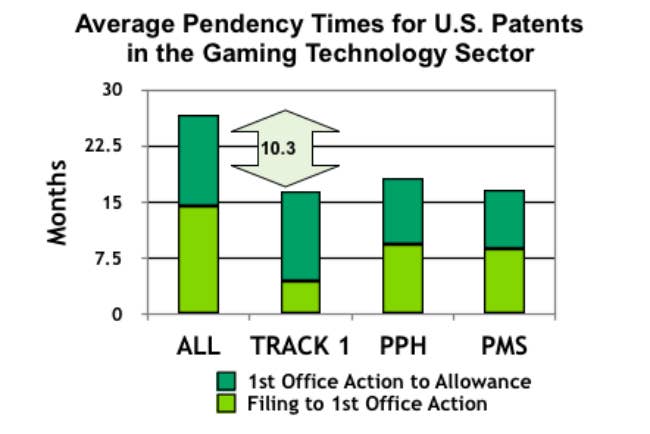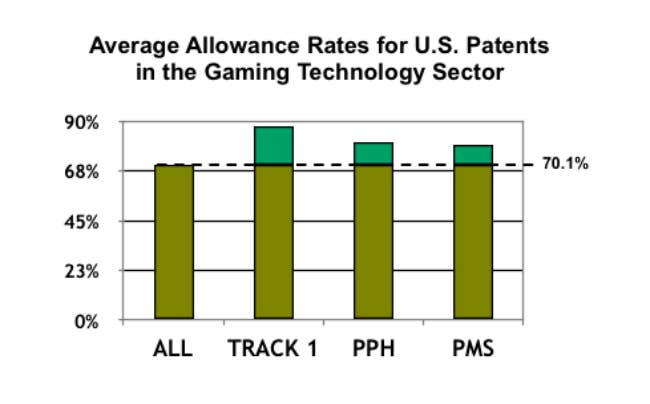How to get your US patent approved faster
IP law expert Bruce Itchkawitz details how games developers can use expediting channels to increase their chance of success at the USPTO
Pursuing patents in the gaming sector can be a long and costly quest, with no guarantee of success. For example, statistics from the United States Patent and Trademark Office's public database show that for U.S. patent applications directed to gaming inventions filed during the past seven years (i.e. after January 1, 2010), the average pendency time is about 27 months. In addition, the average allowance rate for successfully receiving a U.S. patent is about 70%.
The hurdle of long pendency times can deter some companies, particularly startups, from even attempting to patent their inventions. After all, by the time that the U.S. patent has issued, the technology may have become obsolete, thereby reducing the economic value in using the patent to exclude competitors from using the invention. In addition, the allowance rate introduces a level of uncertainty in the process, whereby some companies may be less willing to file patent applications in view of the 30% chance of failure. In the ongoing struggle to conserve cash and operate lean, some startups may be tempted to forego patent protection.
However, many companies don't realize that there are various channels available at the USPTO which can boost their patenting performance. Each of these channels has its own qualifications for entry and is applicable in different circumstances. As described below, besides providing shorter pendency times, statistics show that these channels also provide significantly higher probabilities of success. Savvy companies, both startups and long-established organizations, have successfully utilized these channels to "level up" their patent efforts, achieving patents faster and more reliably.
"Track One": Paying to be prioritized
The most frequently used channel for expediting gaming sector patent applications filed over the past seven years has been the USPTO's "Prioritized Patent Examination" or "Track One" program.
Qualifying for Track One simply requires paying a prioritized examination fee (currently between $1,000 and $4,000, depending on the size of the applicant), along with the standard filing fees and requirements when the patent application is filed at the USPTO. Track One is also available for already-pending patent applications by filing the prioritized examination fee, along with a "Request for Continued Examination" and the corresponding fee.
Under Track One, an applicant pays a premium to have its application examined ahead of other earlier-filed applications. The USPTO's stated goal for Track One is to get the application to final disposition (i.e. allowance, "final" rejection, or abandonment) within one year from filing. An applicant can continue pursuing an application even after a “final” rejection by filing a Request for Continued Examination, but subsequent processing will be conventional and non-prioritized.
By jumping the line to examination, companies can use Track One applications to turbo-charge their patent portfolio development with some quick wins, perhaps to increase the company's value in preparation of a funding round or to more quickly get patent protection for a soon-to-be marketed product.
Patent Prosecution Highway (PPH): Leveraging positive results from foreign patent offices
The next most frequently used channel for expediting gaming sector patent applications filed over the past seven years has been the USPTO's "Patent Prosecution Highway" or "PPH" program.
Under PPH, the USPTO expedites the examination of patent applications which include claims that have already been allowed in corresponding pending applications by a foreign patent office. Currently, the list of foreign patent offices that are eligible for PPH include those in Canada, China, Europe, Japan, Korea, United Kingdom, and about 30 other countries. No extra fees are required to qualify for PPH.
While the USPTO expedites PPH patent applications, it still performs its own examination of the claims, making an independent evaluation of their patentability. The USPTO presumes that the positive result from the foreign patent office indicates that final disposition can be reached more quickly and efficiently than standard examination processing. PPH can be particularly helpful for companies with outside U.S. patenting activities, looking to leverage their successes in foreign patent offices to more quickly obtain the same scope of patent protection in the U.S.
Petition to Make Special (PMS): Expediting in view of inventor's age or poor health
A third expediting channel for gaming sector patent applications is the "Petition to Make Special" (PMS) on the basis of age or health of an inventor of the patent application.
The PMS is filed with the USPTO for a currently-pending U.S. patent application, and is accompanied by evidence showing that the inventor is 65 years of age or older or by evidence showing that the inventor's state of health is such that he or she might not be available to assist in the prosecution of the application if it were to run its normal course. Evidence of age can be satisfied by a statement by the inventor attesting that he or she is 65 or older, or by a statement by a patent attorney attesting to having evidence that the inventor is 65 or older. Evidence of poor health can be satisfied by a doctor's certificate or other medical certificate. No extra fees are required.
Basically, the USPTO is willing to expedite the examination of these patent applications to reduce the possibility of the inventor becoming too ill to work with the patent attorney in pursuing patent protection. PMS is used much less often for gaming inventions than are the Track One or PPH channels, but if the inventor qualifies, PMS can result in a valuable quick win for the applicant.
Pendency Times for Expedited Gaming Patent Applications
For U.S. patents in the gaming sector, each of these three expediting channels (Track One, PPH, and PMS) provides significantly faster allowance as compared to U.S. patents processed conventionally. Figure 1 compares the average pendency times (in units of months) for all U.S. patents in the gaming sector filed during the past seven years (labeled "ALL") to those applications that took advantage of the three expediting channels (labeled "TRACK 1," "PPH," and "PMS").
On average, all U.S. patents in the gaming sector took 26.7 months from filing to issuance as a U.S. patent. Patents processed via Track One reached issuance much faster, by an average of 10.3 months, with an average pendency of 16.4 months from filing to issuance. Patents processed via PPH and PMS also achieved much faster issuances than conventionally processed U.S. patents, with average pendencies of 18.3 months and 16.7 months, respectively.

Processing of a patent application through the USPTO generally includes two separate time periods: (i) the time that the U.S. patent application sits in the queue awaiting its turn to be considered by the USPTO examiner, and (ii) the time after the USPTO examiner has picked up the application, during which the applicant tries to convince the examiner that the patent application should be allowed as a U.S. patent. These two time periods, the sum of which is the total pendency time, are generally demarcated from one another by the USPTO examiner mailing out to the applicant a first "Office Action," a document which lays out the examiner's initial view of whether the patent application meets the standards of patentability under U.S. patent laws.
These two separate time periods of the pendency time are shown in Figure 1 as: (i) time of "Filing to 1st Office Action," and (ii) time of "1st Office Action to Allowance."
For Track One, the average time that the patent application is sitting in the queue is 4.4 months, which is 10 months shorter than the corresponding average time for all patent applications of 14.4 months. While Track One significantly speeds up the time it takes the USPTO examiner to first pick up the patent application from the queue, subsequent processing of the application, including the back-and-forth arguments and responses between the examiner and the applicant, take about the same amount of time for Track One as for conventionally processed applications (averaging 12.0 months for Track One applications and 12.3 months for all applications).
For patents that are processed via either PPH or PMS, the average times that the patent applications are sitting in the queue are about the same as one another (9.4 months for PPH and 8.9 months for PMS), which are significantly shorter than for conventionally processed applications but not as short as for Track One applications. However, for both PPH and PMS, the subsequent processing times (8.9 months for PPH and 7.8 months for PMS) are shorter than the approximate 12 months experienced by Track One applications or conventionally processed applications, resulting in total pendency time reductions that approach the total pendency time reduction of Track One.
Surprisingly, the allowance rates of gaming sector patents processed via these expedited channels show significant improvements as well. Figure 2 compares the allowance rates for all U.S. patents in the gaming sector filed during the past seven years (labeled "ALL") to those applications that took advantage of the three expediting channels (labeled "TRACK 1," "PPH," and "PMS").

Track One applications have an allowance rate almost 18% higher than do conventionally processed applications (a Track One allowance rate of 87.8%). For patents processed via PPH and PMS, the improvement is not as large (about 10% for each), but is still significant.
Example Successes
Various gaming companies have successfully "leveled up" using these expediting channels at the USPTO to excellent effect.
Since 2012, Gamblit Gaming has filed about one-third of its U.S. patent applications via Track One. In doing so, Gamblit has been awarded 74 U.S. patents while outperforming the overall gaming sector averages at the USPTO, with an allowance rate of 98% (compared to the gaming sector's average of 70%) and an average pendency time of 14 months (which is about one-half of the gaming sector's average of 27 months). For another example, since 2014, Game Play Network has filed about two-thirds of its U.S. patent applications via Track One, resulting in 26 U.S. patents, an allowance rate of 100%, and an average pendency time of 16.5 months. These two examples show that Track One can be highly effective for gaming startups for building up their U.S. patent portfolios much more rapidly than conventional processing.
For foreign-based gaming companies, PPH can yield impressive reduction of pendency time as well. For example, since 2013, DeNA Co. has filed about two-thirds of its U.S. patent applications via the PPH process, resulting in 107 U.S. patents with an average pendency time of 17.7 months, which is about ten months less than the gaming sector's average. However, DeNA has not also achieved a boost of its allowance rate by using PPH (67%, which is close to the overall gaming sector's allowance rate of 70%).
IGT provides an example of using PMS, which it has done for about 1% of its patent applications filed over the past seven years. These PMS applications have achieved an allowance rate of 100% and a pendency time of 15.3 months, compared to IGT's overall allowance rate of 89% and overall average pendency time of 24 months.
These examples illustrate that gaming companies looking to bolster their patent efforts should consider utilizing Track One, PPH, or PMS to achieve U.S. patents faster and more reliably.
Bruce S. Ichkawitz, PhD, is a partner at intellectual property law firm Knobbe Martens. Find out more about his work here.







